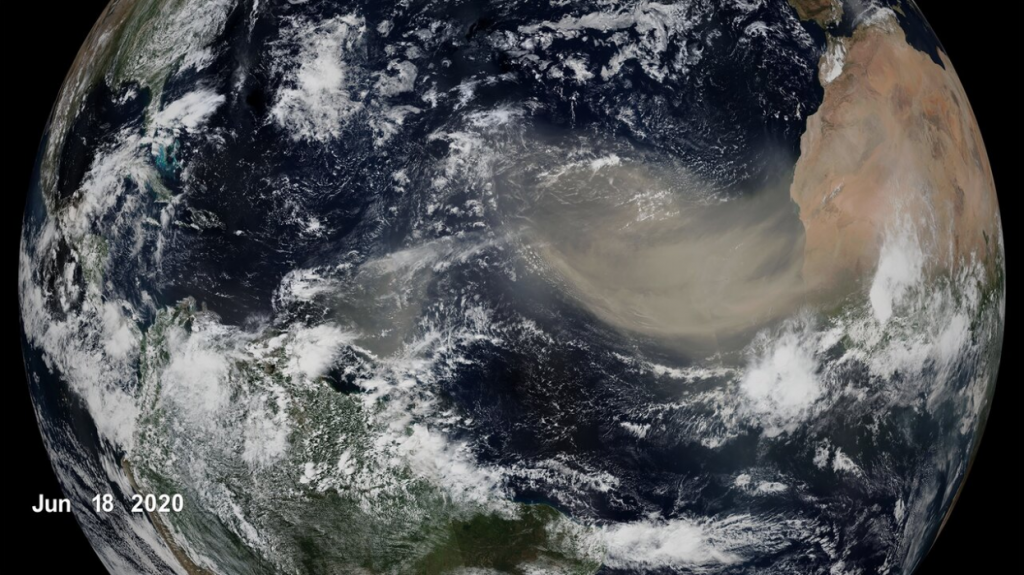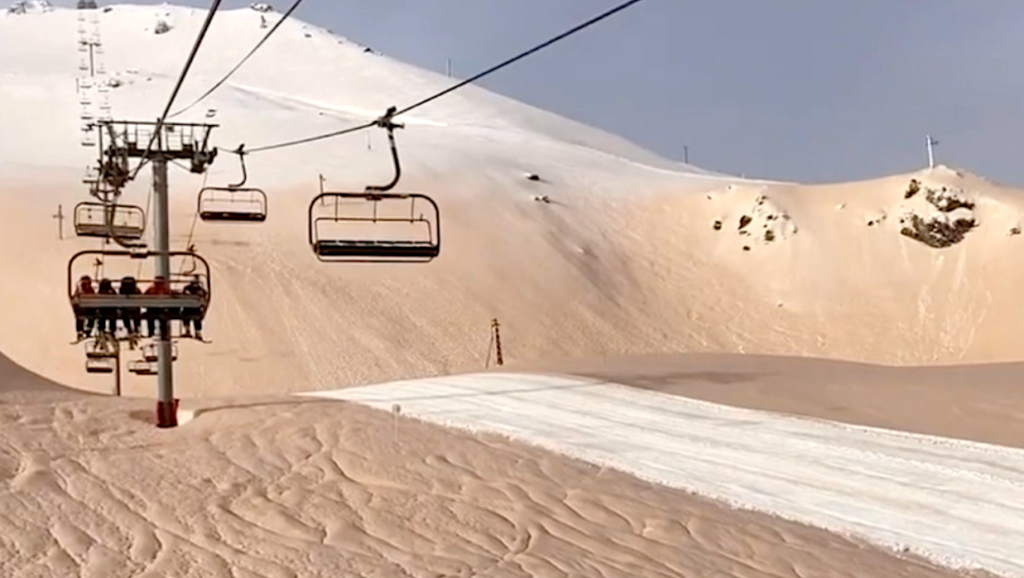What are Saharan dust clouds?
- Every year during the summer, large amounts of dust are lifted off of the Saharan Desert in northern Africa and float west over the Atlantic Ocean and into the Caribbean, eastern US, and Europe (image below).
- According to the World Meteorological Organization (WMO), dust clouds are caused by storm systems moving into a dry area where strong winds are able to lift up the dust across a large region.

Satellite image of a large Saharan dust cloud nicknamed “Godzilla” moving west over the Atlantic Ocean in 2020 (from NASA 2021).
- Saharan dust clouds pick up soil particles containing phosphorus and iron, which then rain down like fertilizer showers (picture below). This is an essential part of global nutrient cycling that allows for the rich biodiversity of North, South, and Central Americas. The dust cloud also helps prevent tropical storms because of its dryness soaking up the humidity that tropical storms feed off of. For these reasons, a normal Saharan dust cloud is essential for global ecosystems and climate.

Saharan dust on cars in Texas (from Houston Chronicle, 2013).
- Despite its ecological importance, Saharan dust can have negative impacts on people, because it degrades air quality. Breathing in large amounts of dust can cause coughing, sneezing, wheezing, and shortness of breath, as well as exacerbate other respiratory problems such as asthma. Breathing in the dust can also worsen health outcomes from COVID-19.
How are Saharan dust clouds related to climate?
Past and present
- The Saharan dust cloud of 2020 (pictured above), was many times larger than in previous years. Consequently, the amount of dust particles raining down was greater than previously recorded.
- Since 2020, the yearly Saharan dust clouds seem to be just as large. In 2022, for example, Spain reported that levels of airborne dust were five times higher than the EU’s recommended threshold of air quality. Areas in Europe that were normally covered with white snow were stained red from the dust (picture below).

Image of a ski resort in France where the snow was dyed red from the Saharan dust (Finch for Accuweather 2022)
- A study by Clifford and others from 2019 reconstructed a 2,000 year history (1-2000 CE) of Saharan dust clouds using evidence from ice cores. The researchers found that the size of annual Saharan dust clouds has been steadily increasing over the past 100 years. The 2020 “Godzilla” dust cloud and the dust clouds since have proven to continue this upward trend.
- Based on this evidence, it appears that currently the frequency and intensity of Saharan dust clouds continues to increase with changes in wind and precipitation patterns as a consequence of global warming. These changes are linked to the widespread desertification in Northern Africa and stronger winds could amplify the Saharan dust transport across the Mediterranean Sea and the Atlantic Ocean.
Future
- Despite the evidence of the increasing amount of airborne dust in the past 100 years, using satellite technology and the trends in anthropogenic climate change, NASA scientists predict that over the next 20-50 years Saharan dust clouds will decrease in size by 30%. This means better air quality, but may have devastating effects on the ecosystem, depriving multiple biomes of essential nutrients, and may also intensify global warming.
- Saharan dust storms are most intense during glacial maximums, and become weak during interglacial periods. The Earth experienced the last glacial maximum about 20,000 years ago, and has been in the current interglacial time period for about 11,000 years. Judging from the climate patterns of the last 2 million years, the Earth is due for another ice age, but the current trends of anthropogenically induced global warming make the future uncertain.
- The temperature of the sea has a profound effect on global winds. When oceans are cold the winds blow stronger and faster. As global warming continues, the winds are declining in strength and speed. The weakened wind picks up and carries less dust. Such winds can’t swiftly push bands of rain over the desert nor dry the desert soil as quickly after rain events. Desert floors become more moist overall, and moist dust doesn’t blow away as readily as dry dust does.
- Dust in the air reflects sunlight, cooling the earth. With less airborne dust, the Earth loses that extra protection, accelerating global warming. Such worsening of climate change can result in less airborne dust. This forms a positive feedback loop that leads to more warming.
References and additional resources
- Alexander H.,“Mysterious dust drops all over Houston and car washes love it”, Houston Chronicle, 2013. https://www.chron.com/news/houston-texas/houston/article/Mysterious-dust-drops-all-over-Houston-and-car-5087977.php.
- Borunda A., “Saharan Dust is Bad for Health. but it’s also Crucial to Earth’s Biology and Climate”, National Geographic, June 2020. https://www.nationalgeographic.com/science/article/concerned-saharan-dust-plume-crucial-to-ecosystem.
- Clifford H. et al, “A 2000 Year Saharan Dust Event Proxy Record from an Ice Core in the European Alps”, JGR Atmospheres, November 2019. https://agupubs.onlinelibrary.wiley.com/doi/10.1029/2019JD030725
- Collins J., “What is the Saharan Air Layer and how does it affect the tropics?”, CBS12 News, July 2021. https://cbs12.com/news/local/how-does-the-saharan-air-layer-impact-tropical-development.
- Finch A., “Ski resort looked like a desert as skies turned red amid major dust storm”, Accuweather, March 2022. https://www.accuweather.com/en/weather-news/ski-resort-looked-like-a-desert-as-skies-turned-red-amid-major-dust-storm/1158193.
- Irfan U., “The “Godzilla” Saharan dust cloud over the US, explained”, VOX, July 2020. https://www.vox.com/2020/7/1/21307053/sahara-dust-storm-2020-godzilla-cloud-saharan-sunset.
- Kaiser C., “Saharan dust turns skies orange over Europe”, CNN, March 2022. https://www.cnn.com/2022/03/16/weather/saharan-dust-europe/index.html.
- Navvro A., “Abnormally Large Dust Cloud Making 5,000-mile trek across Atlantic towards US”, WUSA9, June 2020. https://www.wusa9.com/article/weather/accuweather/abnormally-large-dust-cloud-making-5000-mile-trek-across-atlantic-towards-us/507-beca253d-a170-4795-b527-f623658a1f16.
- Streiff L., “Earth Day Connections: NASA Study Predicts Less Saharan Dust in Future Winds”, NASA, April 2021. https://climate.nasa.gov/news/3076/earth-day-connections-nasa-study-predicts-less-saharan-dust-in-future-winds/.
